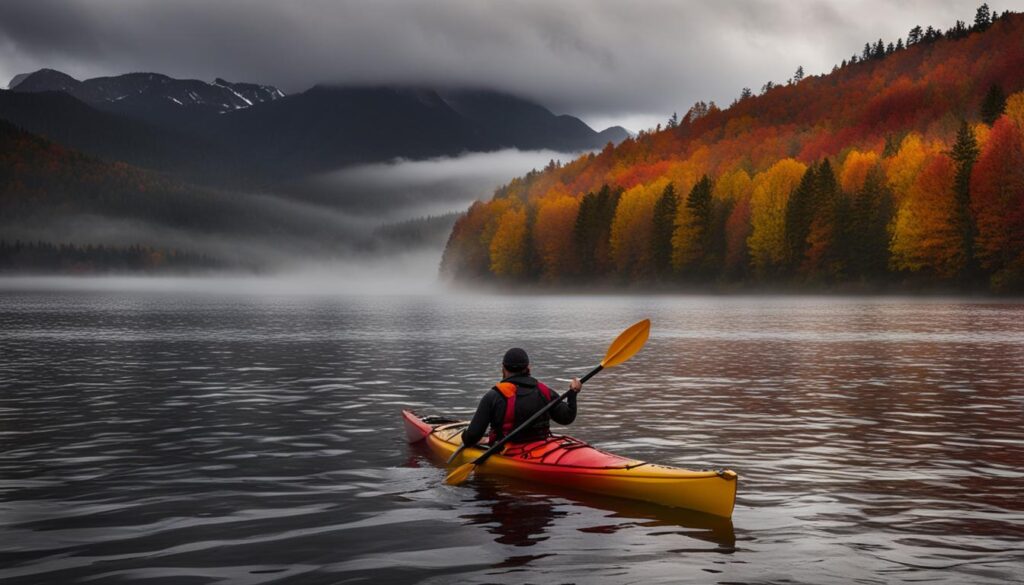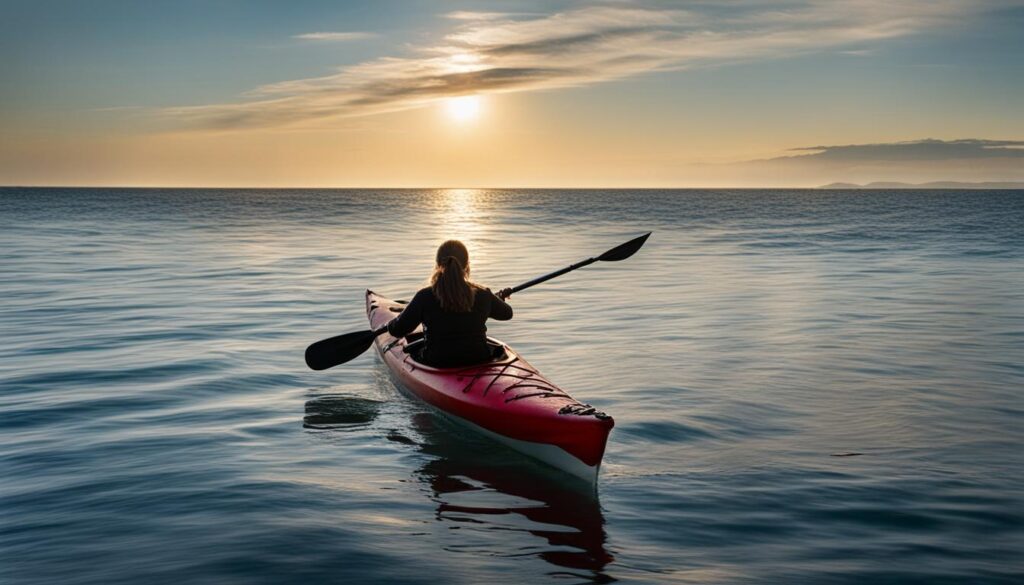In order to stay safe and enjoy your kayaking trips, it is important to be able to recognize signs of weather changes while on the water. By understanding the weather conditions and their potential impact on your paddling activities, you can make informed decisions to modify or abandon your trip if necessary. This section will provide you with the knowledge and skills to interpret weather signs and predict future weather conditions while kayaking.
Key Takeaways:
- Understanding weather signs while kayaking is crucial for safety and enjoyment.
- Local factors such as topology can influence weather conditions on the water.
- Seasonal norms play a significant role in weather patterns for kayaking throughout the year.
- Recognizing specific weather signs on the water, such as sea breezes and eddies, can help you make informed decisions.
- Monitoring detailed weather forecasts and conditions is essential before and during your kayaking trips.
Understanding Local Weather Factors
When it comes to kayaking, understanding the local weather factors is essential for predicting future conditions and ensuring your safety on the water. Topology and other local factors can have a significant impact on the weather, and being aware of these influences can help you make more accurate predictions.
One important local factor to consider is topology, which refers to the shape and features of the land. For example, sea breezes occur when land heats up faster than the ocean, resulting in the flow of cooler air from the sea. This can lead to strong onshore winds later in the day, which can affect your kayaking experience. Valleys and hills can also influence wind patterns, creating updrafts and downdrafts that may impact your paddling activities.
By understanding how topology and other local factors interact with the weather, you can better anticipate changes while kayaking. This knowledge allows you to make informed decisions about when and where to paddle, ensuring that you have a safe and enjoyable experience on the water.
| Local Weather Factors | Impact on Kayaking |
|---|---|
| Topology | Affects wind patterns and can create updrafts and downdrafts. |
| Sea Breezes | Brings strong onshore winds later in the day. |
By recognizing and understanding these local weather factors, you can become more proficient at predicting future conditions while kayaking. This knowledge allows you to plan your trips accordingly and make adjustments when necessary. So, before you head out on your next kayaking adventure, take the time to familiarize yourself with the local weather factors in your area. It’s all part of being a responsible and well-prepared paddler.
Weather Patterns and Seasonal Norms
Different seasons bring about various weather patterns and norms that can impact your kayaking trips. By understanding these seasonal changes, you can better prepare for the highs and lows that each season may bring. Let’s explore how summer, autumn, winter, and spring affect the weather conditions and what you can expect while out on the water.
Summer
In the summertime, highs are typically centered south of the continent, resulting in hot and dry conditions in some areas and wet conditions along the east coast. This means that you may encounter scorching temperatures and minimal rainfall in certain regions. It’s important to stay hydrated and take necessary precautions to protect yourself from the heat. However, along the east coast, you might experience more frequent rainfall, so be prepared for sudden showers and plan your kayaking trips accordingly.
Autumn
As we transition into autumn, the highs begin to move northward, leading to lighter winds. This can create perfect conditions for kayaking, with gentle breezes and calmer waters. However, weather patterns can still vary, so it’s important to stay updated on the forecast and be prepared for any changes that may occur. Dress in layers to accommodate changing temperatures and enjoy the serene beauty of nature during this season.
Winter
During winter, highs cross the continent, bringing wind, rain, and even snow to southern parts of the country. This means that kayaking conditions may be more challenging, with colder temperatures, stronger winds, and the potential for inclement weather. It’s crucial to prioritize safety during this season and check weather forecasts for any warnings or advisories. If conditions are unfavorable, it may be best to postpone your kayaking trip or choose a more sheltered location.
Spring
Spring marks the movement of highs southward, with continued wind and precipitation. Although the weather may be unpredictable during this season, it also brings new life and vibrant scenery. Be prepared for changing weather patterns, including sudden showers and gusty winds. Keep an eye on the forecast and choose a kayaking route that offers shelter from strong winds, allowing you to enjoy the beauty of spring while staying safe.

Recognizing Weather Signs On the Water
When you’re out kayaking, it’s important to be able to recognize weather signs on the water to ensure your safety and enjoyment. Being aware of these signs can help you make informed decisions about your paddling activities and adjust your route accordingly. Here are some key weather signs to watch for:
Sea Breezes
Sea breezes can reach inland and bring strong onshore winds later in the day. These breezes are caused by the temperature difference between the land and the sea. As the land heats up, cooler air from the sea flows in, creating a noticeable breeze. Keep an eye out for these winds, as they can affect your kayaking experience and make paddling more challenging.
Topographic Winds
Topographic winds occur when valleys become warmer than the surrounding hills. This temperature difference leads to breezes flowing up the slopes and down the valley. These winds can be unpredictable and vary in intensity. Pay attention to the topography of the area you’re kayaking in, as it can influence the wind patterns and impact your paddling conditions.
Downslope Winds
Downslope winds are caused by the general circulation on the lee side of mountains and hills. As the wind travels over the terrain, it can create downdrafts that impact the local weather conditions. These winds can be strong and turbulent, so it’s essential to be aware of them while kayaking. Be cautious when paddling near areas with significant elevation changes and keep an eye out for any sudden changes in wind direction and speed.
Eddies
Eddies are circular currents that form behind obstructions in the water, such as rocks or islands. These currents can cause gusts and turbulence, making it challenging to paddle in certain areas. Be observant of any swirling or choppy water and exercise caution when navigating through eddies. Adjust your paddling technique and route to ensure a smooth and safe kayaking experience.
By recognizing these weather signs on the water, you can make informed decisions about your kayaking activities. Remember to always prioritize your safety and adjust your plans accordingly based on the current weather conditions.

| Weather Sign | Description |
|---|---|
| Sea Breezes | Onshore winds caused by temperature difference between land and sea |
| Topographic Winds | Breezes flowing up slopes and down valleys due to temperature variations |
| Downslope Winds | Strong and turbulent winds caused by circulation on the lee side of mountains and hills |
| Eddies | Circular currents behind obstructions, leading to gusts and turbulence |
Monitoring Weather Forecasts and Conditions
Before embarking on a kayaking adventure, it is crucial to stay up-to-date with detailed forecasts and current weather conditions. By monitoring weather forecasts, you can make informed decisions and plan your trip accordingly. The Bureau of Meteorology provides a comprehensive range of forecasts, including wind, rainfall, temperature, waves, and swell. These forecasts allow you to choose the best day for paddling and anticipate any changes throughout the day.
Additionally, it’s important to keep track of streamflows, tides, climate patterns, and river volume forecasts. These factors can greatly impact your kayaking experience. Streamflows and river volume forecasts provide essential information about water levels, helping you gauge the intensity and difficulty of your trip. Tides are particularly significant if you’re kayaking in coastal areas, as they affect water currents and navigation. Stay informed about climate patterns specific to your kayaking location to anticipate long-term weather trends.
To assist you in your planning, here is a summary of the resources you can utilize:
- Detailed Forecasts: Bureau of Meteorology offers comprehensive forecasts for wind, rainfall, temperature, waves, and swell.
- Streamflows: Monitor streamflow data provided by local authorities or water management organizations to understand water levels and conditions.
- Tides: Consult tide charts or use online tools to determine high and low tides, which impact water currents and coastal kayaking routes.
- Climate: Familiarize yourself with the climate patterns and weather norms of your kayaking location to anticipate long-term trends.
- River Volume Forecasts: If kayaking in rivers, check for river volume forecasts to gauge water levels and potential hazards.
By utilizing these resources, you can make informed decisions based on current and future weather conditions. Remember to regularly check forecasts and conditions leading up to your kayaking trip, as weather can change rapidly. Your safety and enjoyment on the water depend on your ability to adapt to weather conditions and make informed choices.
Conclusion
Recognizing signs of weather changes while kayaking is crucial for your safety and enjoyment on the water. By understanding local weather factors, seasonal norms, and specific weather signs on the water, you can adapt your kayaking trips to changing weather conditions.
When out on the water, keep an eye out for sea breezes, topographic winds, downslope winds, and eddies. These signs can help you make informed decisions about your paddling activities and adjust your route accordingly.
Monitoring weather forecasts and conditions is also essential. Stay updated on detailed forecasts for wind, rainfall, temperature, waves, and swell provided by the Bureau of Meteorology. Additionally, pay attention to streamflows, tides, climate patterns, and river volume forecasts to make informed decisions based on current and future weather conditions.
Remember, adapting to weather conditions is key. Stay vigilant, use the available resources, and adjust your plans accordingly to ensure a safe and enjoyable kayaking experience. So, the next time you hit the water, be prepared to navigate the changing weather with confidence.
FAQ
What are some signs of weather changes while kayaking?
Signs of weather changes while kayaking include sea breezes, topographic winds, downslope winds, and eddies.
How can I understand local weather factors?
Local weather factors can be understood by considering topology and other local influences such as sea breezes, valley and hill winds, and downslope winds.
What are the weather patterns and norms throughout the seasons?
In summer, there are hot and dry conditions in some areas and wet conditions along the east coast. Autumn sees lighter winds, while winter brings wind, rain, and snow in southern parts. Spring brings continued wind and precipitation.
What should I watch for on the water to anticipate weather changes?
On the water, watch for signs such as sea breezes, topographic winds, downslope winds, and eddies to anticipate weather changes while kayaking.
How can I monitor weather forecasts and conditions?
You can monitor weather forecasts and conditions by checking the Bureau of Meteorology for detailed forecasts on wind, rainfall, temperature, waves, and swell. Additionally, stay informed about streamflows, tides, climate patterns, and river volume forecasts.





